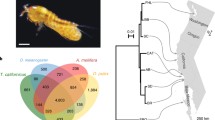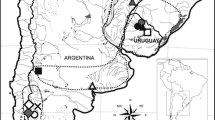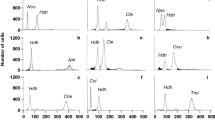Summary
The compositional properties of DNAs from 122 species of fishes and from 18 other coldblooded vertebrates (amphibians and reptiles) were compared with those from 10 warm-blooded vertebrates (mammals and birds) and found to be substantially different. Indeed, DNAs from cold-blooded vertebrates are characterized by much lower intermolecular compositional heterogeneities and CsCl band asymmetries, by a much wider spectrum of modal buoyant densities in CsCl, by generally lower amounts of satellites, as well as by the fact that in no case do buoyant densities reach the high values found in the GC-richest components of DNAs from warm-blooded vertebrates.
In the case of fish genomes, which were more extensively studied, different orders were generally characterized by modal buoyant densities that were different in average values as well as in their ranges. In contrast, different families within any given order were more often characterized by narrow ranges of modal buoyant densities, and no difference in modal buoyant density was found within any single genus (except for the genusAphyosemion, which should be split into several genera).
The compositional differences that were found among species belonging to different orders and to different families within the same order are indicative of compositional transitions, which were shown to be essentially due to directional base substitutions. These transitions were found to be independent of geological time. Moreover, the rates of directional base substitutions were found to be very variable and to reach, in some cases, extremely high values, that were even higher than those of silent substitutions in primates. The taxonomic and evolutionary implications of these findings are discussed.
Similar content being viewed by others
References
Bernardi G (1989) The isochore organization of the human genome. Annu Rev Genet 23:637–661
Bernardi G, Bernardi G (1986) Compositional constraints and genome evolution. J Mol Evol 24:1–11
Bernardi G, Bernardi G (1990) Compositional patterns in the nuclear genomes of cold-blooded vertebrates. J Mol Evol 31:265–281
Bernardi G, Olofsson B, Filipski J, Zerial M, Salinas J, Cuny G, Meunier-Rotival M, Rodier F (1985) The mosaic genome of warm-blooded vertebrates. Science 228:953–958
Bernardi G, Mouchiroud D, Gautier C, Bernardi G (1988) Compositional patterns in vertebrate genomes: conservation and change in evolution. J Mol Evol 28:7–18
Carlson SS, Wilson AC, Maxson RD (1978) Do albumin clocks run on time? A reply. Science 200:1183–1185
Carroll RL (1988) Vertebrate paleontology and evolution. Freeman, New York
Clausen HS (1967) Tropical Old World cyprinodonts. Akademisk Forlag, Copenhagen
Corneo G, Ginelli E, Soave C, Bernardi G (1968) Isolation and characterization of mouse and guinea pig satellite DNAs Biochemistry 7:4373–4379
Cortadas J, Olofsson B, Meunier-Rotival M, Macaya G, Bernardi G (1979) The DNA components of the chicken genome. Eur J Biochem 99:179–186
Cuny G, Soriano P, Macaya G, Bernardi G (1981) The major components of the mouse and human genomes: preparation, basic properties, and compositional heterogeneity. Eur J Biochem 111:227–233
Douchement J, Romand R, Pasteur N (1984) Biochemical differentiation in West-Africa cyprinodontoid fish of the genusAphyosemion. Biochem Syst Ecol 12:325–333
Eldredge N, Gould SJ (1972) Punctuated equilibria: an alternative to phyletic gradualism. In: Shopf JM (ed) Models in paleobiology. Freedman, Cooper & co, San Francisco, pp 82–115
Filipski J, Thiery JP, Bernardi G (1973) An analysis of the bovine genome by Cs2SO4/Ag+ density gradient centrifugation J Mol Biol 80:177–197
Gosline WA (1970) A reinterpretation of the fish order Gobiesociformes. Proc Calif Acad Sci, Ser 4 37:363–382
Grantham R, Gautier C, Couy M, Mercier R, Paré A (1980) Codon catalog usage and the genome hypothesis. Nucleic Acids Res 8:r49-r62
Graves JE, Somero GN (1982) Electrophoretic and functional enzyme evolution in four species of eastern pacific barracudas from different thermal environments. Evolution 36:97–106
Hudson AP, Cuny G, Cortadas J, Haschemeyer AEV, Bernardi G (1980) An analysis of fish genomes by density gradient centrifugation. Eur J Biochem 112:203–210
Li W-H, Tanimura M, Sharp PM (1987) An evaluation of the molecular clock hypothesis using mammalian DNA sequences. J Mol Evol 25:330–342
Liem KS, Greenwood PH (1981) A functional approach to the phylogeny of the pharyngognath teleosts. Am Zool 21:83–101
Macaya G, Thiery JP, Bernardi G (1976) An approach to the organization of eukaryotic genomes at a macromolecular level. J Mol Biol 108:237–254
Mandel M (1969) New approaches to bacterial taxonomy: perspective and prospects. Annu Rev Microbiol 23:239–274
Mandel M (1973) DNA base compositions of eucaryotic protists. In: Sober HA (ed) Handbook of biochemistry, ed 2. CRC Press, Boca Raton FL
Marmur J, Falkow S, Mandel M (1963) New approaches to bacterial taxonomy. Annu Rev Microbiol 17:329–372
Matsuura K (1979) Phylogeny of the superfamily Balistoidea (Pisces, Tetradontiformes). Mem Fac Fish Hokkaido University 26:49–169
Monod T (1986) Les scarides: quelques observations sur le crane et le squelette pharyngien. Oceania 12:339
Mouchiroud D, Fichant G, Bernardi G (1987) Compositional compartmentalization and gene composition in the genome of vertebrates. J Mol Evol 26:198–204
Mouchiroud D, Gautier C (1988) High codon-usage changes in mammalian genes. Mol Biol Evol 5:192–194
Mouchiroud D, Gautier C (1990) Codon usage changes and evolutionary rate between man and rat. J Mol Evol (in press)
Mouchiroud D, Gautier C, Bernardi G (1988) The compositional distribution of coding sequences and DNA molecules in humans and murids. J Mol Evol 27:311–320
Nelson JS (1976) Fishes of the world, ed 1. Wiley, New York
Nelson JS (1984) Fishes of the world, ed 2. Wiley, New York
Normore WM, Brown JR (1973) Guanine+cytosine (G+C) composition of bacteria. In: Sober HA (ed) Handbook of biochemistry, ed 2. CRC Press, Boca Raton FL, pp H24–74
Parenti LR (1981) A phylogenetic and biogeographic analysis of cyprinodontiformes fishes (Teleostei, Atherinomorpha). Bull Am Mus Nat Hist 168:335–557
Perrin P, Bernardi G (1987) Directional fixation of mutations in vertebrate evolution. J Mol Evol 26:301–310
Pizon V (1983) Organisation des séquences nucléotidiques dans les génomes de poissons. Thèse de 3è cycle, Université Paris VI
Pizon V, Cuny G, Bernardi G (1984) Nucleotide sequence organization in the very small genome of a tetraodontid fish,Arothron diadematus. Eur J Biochem 140:25–30
Rosen DE (1982) Teleostean interrelationships, morphological function and evolutionary inference. Am Zool 22:261–273
Saccone C, Pesole G, Preparata G (1989) DNA microenvironments and the molecular clock. J Mol Evol 29:407–411
Salinas J, Zerial M, Filipski J, Bernardi G (1986) Gene distribution and nucleotide sequence organization in the mouse genome. Eur J Biochem 160:469–478
Sarich VM (1977) Rates, sample sizes, and the neutrality hypothesis for electrophoresis in evolutionary studies. Nature 265:24–28
Stiassny MLJ, Jensen JS (1987) Labroid intrarelationships resisted: morphological complexity, key innovations, and the study of comparative diversity. Bull Mus Comp Zool 151:269–319
Sueoka N (1988) Directional mutation pressure and neutral molecular evolution. Proc Natl Acad Sci USA 85:2653–2657
Thiery JP, Macaya G, Bernardi G (1976) An analysis of eukaryotic genomes by density gradient centrifugation. J Mol Biol 108:219–235
Wolfe KH, Sharp PM, Li W-H (1989) Mutation rates vary among regions of the mammalian genome. Nature 337:283–285
Zehren SJ (1987) Osteology and evolutionary relationships of the boarfish genusAntigonia (Teleostei: Caproidae). Copeia 3:564–592
Zerial M, Salinas J, Filipski J, Bernardi G (1986) Gene distribution and nucleotide sequence organization in the human genome. Eur J Biochem 160:479–485
Zuckerkandl E (1987) On the molecular evolutionary clock. J Mol Evol 26:34–46
Zuckerkandl E, Pauling L (1962) Molecular disease, evolution and genetic heterogeneity. In: Kasha M, Pullman B (eds) Horizons in biochemistry. Academic Press, New York, pp 189–225
Author information
Authors and Affiliations
Rights and permissions
About this article
Cite this article
Bernardi, G., Bernardi, G. Compositional transitions in the nuclear genomes of cold-blooded vertebrates. J Mol Evol 31, 282–293 (1990). https://doi.org/10.1007/BF02101123
Received:
Revised:
Accepted:
Issue Date:
DOI: https://doi.org/10.1007/BF02101123




